Gum Springs
The second community examined in this project is Gum Springs. Created by West Ford in 1857, Gum Springs remains in the Southeast corner of Fairfax County between Mount Vernon and Alexandria within the exact boundaries West Ford purchased over 150 years ago. Still populated by many of West Ford’s descendants, Gum Springs has relied upon its strong community and cultural structures to persist throughout the decades. While the community has faced many struggles in the last seventy-five years, their perseverance is a testament to the power of Black geographic claims to space and the work of Gum Springs to maintain their community.
The focus of this section will be on the mid-twentieth-century in Gum Springs and the work done by the community to resist displacement and secure funding for their community as they fought for better homes, infrastructure, and opportunities. The first section, “Progress in the County Is Only Progress For Some,” examines how the ideas of progress and massive expansion in Fairfax County during the post-war period ushered in slow violence in Gum Springs through stagnated and uneven development. Following this, the second section, “Displaced in Place In Gum Springs,” demonstrates how slow violence through structural inequalities and hygiene laws created “displacement in place” in Gum Springs and how these hygiene laws and continued disinvestment facilitated physical displacement. Finally, “Community Action Then and Now” observes how Gum Springs residents and the surrounding community resisted multifaceted forms of displacement by relying upon old and new community structures and organizations. This section describes how these community structures evolved in the decades following Gum Springs fracturing and whether they can survive as a historic Black community.
